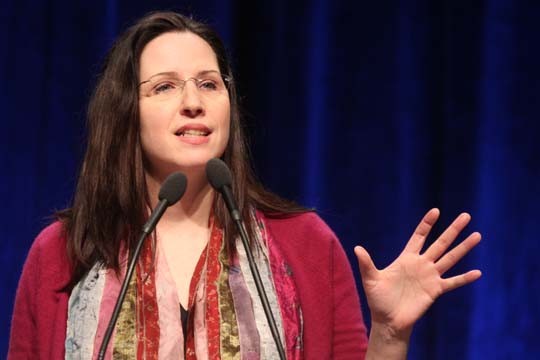Okay, close your eyes and think of the Canadian labour movement. What do you see? C'mon, be honest. You're picturing a middle-aged white guy, sporting a robust beer belly under an XL union t-shirt, likely with placard in hand, defiantly standing on a picket line.
This is classic union, North American edition. We've typecast ourselves. The defenders of labour rights, the champions of working people, have become a relic of the past. At times we're almost a parody of ourselves, a walking/talking vintage edition of class struggle: same t-shirts, same placards, same songs and chants.
It seems while the world is intent on changing, with perpetual upgrades, at least in terms of appearances (think Harper's baby blue sweater), the labour movement has been resolute in maintaining the status quo. Corporations and right-wing governments are constantly engaging in efforts to re-brand and re-frame themselves. In contrast, we in the labour movement seem resistant to change.
Many of us working with labour on media and communications have come to terms with the fact that our unions are allergic to re-branding. We have reconciled ourselves with the reality that our movement is always going to look and sound a bit retro, circa 1985, Arial Bold font.
CLC CONFERENCE SPARKS A CONVERSATION
With this notion in mind, the last place that one expects to hear a forward-looking conversation about how labour can be "brand conscious" and media savvy is at a traditional trade union conference hosted by an organization that represents the entrenched leadership within the sector.
Yet, it was at the Canadian Labour Congress' first-ever national political action conference in Toronto on March 22 to 24 where a dialogue about labour's resistance to re-branding took place.
The conference, which was the first initiative of this scope for the CLC, provided several opportunities for the over 1,500 delegates to participate in various discussions on how labour can become more aware of its media profile and communicate more effectively with a broader cross-section of Canadians, using traditional as well as new media tools.
Speakers such as Canadian Centre for Policy Alternatives Ontario director Trish Hennessy, NOW Communications president and CEO Marie Della Mattia, Broadbent Institute senior advisor Kathleen Monk, TAXI general manager Christian Quenneville, Ontario Federation of Labour communications director Joel Duff, and Toronto & York Region Labour Council organizer Jennifer Huang, were among the various experts speaking about how to improve the Canadian labour movement's image and communication strategies.
TAKING A GOOD LOOK IN THE MIRROR
The first step in the debate was setting the record straight on how the labour movement is seen by average Canadians. For years, we've been insular, refusing to look outward to gauge what the average Canadian thinks of us. When it came to soliciting opinions about our brand and image, we've acted like the 40-year-old confirmed bachelor still living in his mother's basement, confused about why no one wants to date us when our mom assures us that we're a real catch.
NOW Communications' Marie Della Mattia says the labour movement needs to recognize that there's a disconnect between the average union activist and the average Canadian. Speaking to a room full of trade union activists, she states: "Brothers and sisters, we are not Regular Human Normal People." Elaborating on this concept, she explains, "regular, human, normal people are people who are going on about their lives, their families are the most important thing to them, whether they have kids or not. They have jobs that they may like but it's not everything to them. They worry about their future and their present in competing ways. They think about the taxes they have to pay, they don't always think of themselves first, though. Most people are more altruistic than we think."
"These folks are not who we see every day, or who we talk to every day. Sometimes we forget that we have a connection to them and we need to foster it. When we talk in the shorthand that we have with each other, they don't understand. The language of the labour movement is not the same as the language of the rest of the public."

Marie Della Mattia
Della Mattia states that the average person only sees and hears about the labour movement at points of crisis, such as during a strike. "In these moments they're seeing labour getting in the way of their enjoyment of their lives. When labour is on the street and I'm on the sidewalk, we are separate."
Canadian Centre for Policy Alternatives' Trish Hennessy explains how the corporate agenda assists in entrenching these negative associations about the labour movement. "The corporate agenda pushers will be using American tried-and-tested divide-and-conquer tactics to pit union workers against the rest of Canadians. They'll cast unions as a self-interested group that abuses its power at the expense of 'the rest of us.'"
Della Mattia notes that, often, average Canadians are left with problematic, contradictory impressions regarding the labour movement. "People think that we're self-interested and greedy fat cats, but, at the same time, they think that we're protecting workers and their families from the employer. They might be envious of the privileges that people who are part of unions enjoy and want those for themselves, and yet they may resent the people who have them. They think 'Why should someone who cleans toilets in a hospital get paid more than me, who cleans a toilet in an office building?'"
WHAT'S IN IT FOR EVERYONE
"If we spend all our time engaging in an argument with the Conservatives, who want to get rid of us, we're playing into the contradictions; we're giving more evidence that we're in a pitched battle," cautions Della Mattia. She notes that the best way to attract people towards the labour movement is to project a positive message about what we have to offer. "Instead of trying to contradict what people don't like about us, we should cultivate what people like about us."
Della Mattia admits the difficulty is not in how we communicate the message but what message we are communicating. She notes that, at times, the labour movement is too internally focussed, alienating those who are not part of our membership.
"I do believe that there are people in the labour movement who think that the things that we are doing, and the causes that we take up, should benefit everyone. And there are people who believe that the things that we are doing and the causes that we take up should benefit our members. If we don't exist to make things better for everyone through our work on issues like public services and pensions, and create changes that bring these kinds of things to every Canadian, no amount of branding and communications will help us."
She explains that the difficulty is always finding opportunities to engage in a broader dialogue that speaks to people's aspirations, instead of getting lost in insular debates that only concern our members. "Our challenge is always to help people understand the bigger issues involved."
According to Della Mattia, "Your real power is when you talk about what's in it for everyone."
THE FIVE-POINT PLAN
Hennessy believes that a new approach to re-branding the labour movement can be encapsulated in a five-point plan. She posits that the first step is to avoid defensiveness. "The challenge is not to get stuck in defensive mode. When you're in defensive mode, it means you are in retreat. Make sure people see you in a proactive role that highlights the struggle unionized and non-unionized workers have in common, in the face of the corporate agenda."
The next step is to define the threat. According to Hennessy, 53 per cent of Canadians and 70 per cent of union members believe that trade unions play a necessary role in society and everyone will be worse off if the government succeeds in weakening them. "Your job," she says, "is to grow those numbers."
Like Della Mattia, Hennessy stresses the need to speak to people's aspirations as the third step in her communications plan. "Hope is a powerful emotion to work from. It's more powerful than defensiveness. If the public only hears from you when you're fighting a wage freeze, they only see you in defensive mode. Turn your moral outrage at the corporate agenda into a lightning rod of inspiration and hope."

Trish Hennessy
To attract people to the conversation, the labour movement needs to start with a point of connection, explains Hennessy, as step four. Finally, she explains that the ultimate goal is to "grow the tent," saying, "Our potential audience is bigger than we think." Addressing labour activists, she says, "20 per cent of the people are with you, 20 per cent are against, 10 per cent don't care. Most importantly, 50 per cent are waiting to be convinced. Your challenge is to start a conversation with that 50 per cent who are waiting to be convinced."
Hennessy laments that the mistake the labour movement often makes is that "our efforts and meagre resources are trained on the 20 per cent who are already with us."
BECOMING THE MEDIA
"It's time to stop complaining about the media and start becoming the media," states the Ontario Federation of Labour's communications director, Joel Duff. He believes that a serious engagement with social networking tools such as Twitter and Facebook is a necessary component to any media strategy that the labour movement sets out in the future, as these online tools have taken up a greater role in how people receive their news and information. "The labour movement needs to learn how to use social media tools to engage the public where they're at, rather than waiting for the public to come to us."
According to Duff, these tools are readily available to most people and can play an important part in breaking the divisions between average Canadians and trade unions by inviting people to directly engage in the conversations about good jobs and income security, which unions are already part of.
Hennessy also agrees that average trade unionists have an important role to play when it comes to improving the public profile of the labour movement.
Speaking from the podium to a large hall containing hundreds of union delegates, she states, "Each and every one of you in this room has the power to connect with other workers and start a conversation with the rest of Canadians about the point of connection that you have with them: to tell the story of what's at stake if Canadians lose their right to unionized work; to reinforce how unionized workers contribute to well-being in our communities; how intricately unions are connected to the health of the middle class; how unions are part of the solution to reducing income inequality in Canada."
Della Mattia adds, "It's the critical mass of all those voices saying all the same things in the same way that elevates that message. Sometimes we think that by saying it once or twice, that's enough. But what succeeds is repetition: people saying the same things over and over again. We can and should be saying the same things all the time about what the benefits of unions are and what they offer the average person."
GIVING LABOUR A MAKEOVER
Della Mattia explains that labour needs to find opportunities to communicate to the average Canadian that "Our values are the same as yours." She notes that, often, people look at the trade union movement and "see people who don't look or sound like them."
Duff also offers a practical tip on how to use social media to showcase a more reflective image of the labour movement. "In the past when I photographed events like rallies and conferences my camera lens was focussed on the podium. Now, I'm turning my camera towards the audience. I'm amplifying the reach of our message by treating my photos as a medium for social media engagement. By taking people's photos and sharing them on Facebook and other social media applications, I allow people to enter the conversation."
He states that by simply sharing their photos, these individuals expand the networks open to unions for conversations with people that we may not have an immediate connection to. "Every time they re-share a photo of themselves at a union event with their personal networks of friends and acquaintances, they are expanding our audience and the image of the kinds of people who are involved in the labour movement."
The Toronto & York Region Labour Council's Jennifer Huang stresses that this idea of relating to a broader range of Canadians becomes even more critical when looking at the statistical information about Canada's changing population.
She says "one in five Canadians, 6.4 million people, speaks a first language other than English, French or an Aboriginal language. Are we talking to them?" Huang argues that an outreach and communications strategy centred on these growing communities of immigrant workers is essential in order for the labour movement to remain relevant. "It is really, really important that labour gets the message out not just in English but in multiple languages. Communicating in languages other than English is essential to these new and growing communities of immigrant workers."
"We need to train frontline workers to speak about the issues," she says. "The message is more powerful when it comes from rank and file, as opposed to the leadership."

Jennifer Huang
Working to realize this vision, Huang has been spearheading a project through the Toronto & York Region Labour Council that has been identifying trade union members from the Chinese community, one of the largest ethno-linguistic groupings in the Greater Toronto Area, and training them to be spokespeople and ambassadors for the labour movement. The project has entailed the creation of language-specific material on key issues, as well as the identification of Chinese language spokespeople who can connect with Chinese media outlets.
Speaking about this effort, she notes, "It's using union members who are Chinese and building up political and trade union consciousness so they can tell their friends and neighbours about the good work of unions."
Huang explains that a new approach to communications must take into account the increasingly important role of the ethnic media. "Ethnic media cannot be ignored. We need to use our own members to share the difference unions make in people's lives. This is a way of engaging and building."
While Huang stresses the importance to the labour movement of relating to the new and changing demographic of workers, she also notes that there's a political reason for being proactive about reaching out to these ethnic communities. "This work is important because Canadian society is changing, but also important in terms of our electoral strategy. The Harper government, particularly Minister of Immigration Jason Kenney, is courting the ethnic vote. If we don't attempt to outreach to these communities as well, they will only hear one side of the story."
WHY CHANGE?
You may argue, quite rightly, that the struggle continues. You may say yesterday's battles over a living wage, workplace security, benefits and pensions are as relevant today as ever.
I'll counter with an old Canadian trademark courtesy of our celebrity theorist Marshall McLuhan: "The medium is the message." Meaning that, by looking and sounding like the same unions of 10, 20, or 30 years ago, we make people feel as though the labour movement is a relic of the past, out of touch with people's modern needs and no longer relevant to the lives of average Canadians. In turn, by looking and sounding more like the people that we want to communicate with, we invite them to see the labour movement as their voice in a struggle for a better future for them and their kids.
Sima Sahar Zerehi is a journalist, communications strategist, college professor and new media buff. She has done extensive research and advocacy work in the area of immigration, labour, and human rights. In her daydreams she imagines herself as an artist and photographer.










